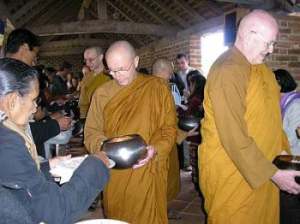Được viết bởi Ông Choi Tuck Wo, báo The Star, ngày 30 tháng 10, 2005
Luân Ðôn, Anh Quốc – Apar khabar? (có nghĩa Ông (hay Bà) khỏe không ?) và Malaysia Boleh! có lẽ là tiếng chào quen thuộc khi người Mã Lai gặp nhau hay là thói quen nhiệt tình của dân bản xứ.
Nhưng diễn cảm này chắc chắn gợi lên sự ngạc nhiên êm đềm khi những lời này đến từ một vị Cao Tăng của Tu viện Phật giáo Nguyên thủy lớn nhất ở Anh quốc.
Lại nữa, Đại đức Ajahn Vajiro không phải chỉ là một tỳ khưu phương Tây khác; Sư được sinh tại Mã Lai và đôi khi tự xem mình như người Á Châu hơn là Âu Châu.
Thật vậy, vị tỳ khưu 52 tuổi cảm thấy rằng một số thiện tín của tu viện là người Mã Lai sinh tại Anh quốc là “dân Anh nhiều hơn tôi nữa.”
Thật thích thú khi cả hai vị, Đại Đức Vajiro và Đại Đức trụ trì Ajahn Sumedho của tu viện Phật giáo Amaravati ở Hertfordshire, 48 cây số tây bắc của Luân Đôn, có mối liên hệ kỳ diệu với người Mã Lai. Ngài trụ trì trải qua hai năm ở Mã Lai trước khi chuyển sang Thái Lan nơi Ngài sống trong lâm tự viện của Đại Lão Hòa thượng Thiền sư lỗi lạc Ajahn Chah trọn 10 năm.
Hiện tại vị Tăng duy nhất sinh tại Mã Lai của Hội Tăng già thuộc tu viện, Đại đức Vajiro được tuyển chọn để nhận y kathina do hoàng gia dâng cúng trong ngày lễ dâng y Kathina vào Chủ nhật qua. Đại đức Vajiro nói rằng Ngài xem như đó là một danh dự lớn lao để thọ lãnh y cà sa do Đại Sứ Thái Lan ở Anh quốc là Ông Vikrom Koompairot, nhân danh Vua Bhumipon ở Thái Lan.
Nghi lễ này là điểm nổi bật nhất của buổi lễ dâng y, được bắt đầu với Đại đức Sumedho và Đại đức Vajiro hướng dẫn hai nhóm Chư Tăng, Ni và các giới tử thọ nhận thực phẩm cúng dường từ thiện tín đứng xếp hàng quanh tu viện.
Sau phần dâng cúng và thọ thực, y kathina được nhiễu hành quanh bảo tháp. Sau đó là nghi lễ quy y Tam Bảo và thọ ngũ giới của thiện tín cũng như Chư Tăng tụng kinh Paritta.
Qua nhiều thế kỷ, truyền thống Kathina ngày nay là một lễ kỷ niệm mà thiện tín cúng dường y cà sa đến Chư Tăng sau mùa an cư kiết hạ (vassa).
Lòng Từ Ái
Cơ bản của tu viện là một hoạt động tích cực từ nhóm người Mã Lai kết hợp với đa số hội đoàn người Tích Lan và người Thái trong những buổi lễ lớn. Trong hội chúng có vị Phật tử Mã Lai làm việc về thông tin vi tính là Ông Sharon Chan, người thường dự vào các buổi lễ dâng y Kathina hàng năm từ năm 2000.
Ông Chan, thường dự vào các lớp hành thiền và thuyết pháp ở tu viện, diễn đạt rằng đây là nơi an tĩnh và cư dân rất thân thiện.
Tu viện tọa lạc nơi thôn quê yên tĩnh giữa các rặng đồi và cây cỏ tươi tốt, ngôi tu viện 25 mẫu Anh (10ha) được thành lập vào năm 1984 do Đại đức Sumedho. Amaravati, có nghĩa là “Bất tử” trong phạn ngữ Pali, là một trung tâm thuyết giảng và thực hành Phật Pháp cho Chư Tăng và thiện tín.
Các hoạt động trong tu viện gồm các lớp hành thiền thường xuyên, các buổi thuyết pháp và các khóa thiền. Tu viện cũng có thư viện, chánh điện và nơi hành thiền riêng biệt. Trên hết, trung tâm là một nơi chính yếu của cộng đồng Phật tử, thiện tín gần xa đã được lôi cuốn bởi Giáo pháp.
(tinhtan luoc dich)
The Malaysian connection
BY CHOI TUCK WO , The Star, Oct 30, 2005
London, UK -- Apa khabar? (How are you?) and Malaysia Boleh! (Malaysia Can!) may sound familiar when Malaysians greet each other or get caught up in a nationalistic fervour.
 Venerable Ajahn Vajiro: Born in Bangsar, Kuala Lumpur. — Pictures by CHOI TUCK WO
Venerable Ajahn Vajiro: Born in Bangsar, Kuala Lumpur. — Pictures by CHOI TUCK WOBut the expressions certainly evoked a pleasant surprise when they came from none other than a senior bhikkhu (monk) of Britain’s largest Theravada Buddhist monastery.
Then again, Venerable Ajahn Vajiro is not just another Western monk; he was born in Malaysia and sometimes regards himself as more Asian than European.
Indeed, the 52-year-old bhikkhu feels that some of the temple’s Malaysian devotees born in Britain are “even more English than me”.
“I was born in a hospital in Bangsar (in Kuala Lumpur),” he said matter-of-factly, in an apparent reference to his maternal French grandmother and her English husband.
“But I sudah lupa banyak lah (But I’ve forgotten much of it),” he continued humbly although he could still speak a smattering of Bahasa Malaysia.
Interestingly, both Vajiro and temple abbot Venerable Ajahn Sumedho of the Amaravati Buddhist Monastery in Hertfordshire, 48km northwest of London, have that uncanny Malaysian connection. The abbot spent two years in Malaysia before moving on to Thailand where he lived in the forest monasteries of renowned meditation master Venerable Ajahn Chah for 10 years.
Vajiro, who always felt at home whenever he visited Malaysia, said Kuala Lumpur had changed a lot compared to the 1960s. “The tallest building then was 11 storeys high,” he said, adding that he liked the country and its multi-culturalism.
A vegetarian who loved durians, Vajiro’s face lit up when asked about his favourite Malaysian food, as his mind raced back to the exotic fare, prompting him to remark: “One can hardly get gula melaka in England.”
He said he did not encourage people to make profit from dealing in meat and animals, which he described as a wrong form of livelihood. He admitted, though, that “I used to like satay”.
DAILY RITUAL: Venerable Ajahn >>

Sumedho (right) leading other monks in receiving alms food offerings from devotees at Amaravati Buddhist Monastery in Hertfordshire
Kathina robe
Vajiro also spoke of his admiration for Venerable Dhammananda in the Brickfields Buddhist Vihara and other temples in Malaysia.
“I haven’t been to Malaysia very often. However, I very much appreciate the good work done there,” he said.
At present the only Malaysian-born bhikkhu among the monastery’s Sangha community, Vajiro was selected to receive the royal kathina robe during their Kathina celebrations last Sunday. Vajiro said he considered it a great honour to be presented with the robe by Thai Ambassador to Britain Vikrom Koompairot, on behalf of King Bhumipon of Thailand.
The ceremony was the highlight of the celebrations, which began with Sumedho and Vajiro leading two groups of monks, nuns and novices to receive alms food offerings from devotees who lined up around the temple compound.
After the dana offerings and sharing in the meals, the kathina cloth was taken around the stupa in a procession. This was followed by the taking of the three refuge and five precepts by the lay community as well as paritta chanting by the sangha community.
Having evolved over the centuries, the kathina tradition is now a celebration in which the lay community offers the cloth to the sangha after the rains retreat (vassa).
Heart-warming
The temple ground was a hive of activity as a handful of Malaysians joined the majority of Sri Lankan and Thai communities in the day-long celebrations. Among them was Malaysian IT software consultant Sharon Chan, who has taken part in the temple’s kathina celebrations every year since 2000.
“It’s a very heart-warming and meaningful event,” said the Penangite, who also helped out in the kitchen and other chores.
Chan, who attends meditation classes and dhamma talks at the monastery, described the place as calm and the resident community friendly.
Joan Ong Corey, also from Penang, was spotted with her two children, Faye, nearly three years old, and Luke, eight months. “Both of them generally behave well in the temple,” she said, adding that she finds peace and quiet in the surroundings.
Restaurant chef Low Tian How said the monastery was the perfect setting for meditation and learning of Buddhism. “It’s so serene here,” said Low from Klang, who came to the UK five years ago.
Set in the tranquil countryside amidst rolling hills and lush greenery, the 10ha monastery was founded in 1984 by Sumedho. Amaravati, which means “Deathless Realm” in Pali, is a centre of teaching and practice for people in monastic or lay life.
The monastery’s activities include regular meditation classes, dhamma talks and meditation retreats. The monastery also houses a library, meeting hall and separate retreat area. Above all, the centre holds a special place in the heart of the Buddhist community, who come from far and near to be inspired by Buddha’s teachings.
http://www.buddhistchannel.tv/index.php?id=3,1881,0,0,1,0
0 Comments:
Đăng nhận xét
<< Home